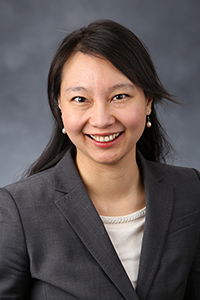Fluids Move Us Forward
Professional engineer Dr. Amy Tsai’s passion for fluids began flowing early in her childhood. At about five years old, she observed a rainbow pattern on a wet surface that refracted light in waves of different colours. Now, she knows this colourful sight is the interference of light reflected off a thin layer of oil on top of water, but at the time she wondered if anyone else saw the vibrant pattern. Her curiosity led her to a career in engineering, where she studies fluid mechanics and collaborates with experts across academia and industry as a Canada Research Chair and a professor in the Faculty of Engineering at the University of Alberta.
Tsai studies how fluids flow all around us, moving in small and large scales—from the air we breathe to the fuels that drive our energy sector—and how they interact with surrounding surfaces. She implements her findings in industry processes to innovate underground carbon storage, fight wildfires, and extract oil more effectively. “Understanding fluids and applying that understanding well is an art,” explains Tsai.
Innovating with carbon dioxide
Tsai’s passion for fluid mechanics enabled her to work on research projects at prestigious institutions across Europe and North America, gaining knowledge and expertise she would bring to the University of Alberta’s Mechanical Engineering Department. Tsai has created a niche for herself, establishing a role teaching and carrying out research while collaborating with industry on multidisciplinary projects throughout Alberta. She is working with industry experts to solve problems related to carbon dioxide (CO2) storage and extinguishing wildfires. “Solving the problems draws me in—contributing to the community is the real challenge,” says Tsai, who wants her students to see the full impact of their work on the world.
She and her research team are currently studying microfluidics—the behaviour and manipulation of fluids that are constrained to a small scale—focusing on how CO2 can be absorbed into naturally occurring saline aquifers. These underground geological formations, which consist of water-permeable rocks saturated with a saltwater solution referred to as brine, can store CO2 captured from nearby power plants. The CO2 is transferred to the saline aquifer and pumped underground to be absorbed into the brine and encapsulated in areas that have held fluids for millions of years. Using microfluid simulations and models, Tsai is studying how the salt concentration of an aquifer’s brine solution will impact the amount of CO2 that can be stored, and how long it will take to dissolve into the brine solution.
When researchers partner with industry to create solutions that improve our built environment, this creates an advantage for all parties involved, explains Tsai. One such project involves engineers and geoscientists across Alberta who use CO2 to improve oil extraction methods. CO2 is much more effective at displacing oil than traditionally used steam—it dissolves into the oil, moving more oil with less work. Like the saline aquifers, once the oil is extracted, the underground cavity that used to hold the oil deposit can store excess CO2 that would otherwise be released to atmosphere.A more effective firefighting fluid
Tsai and her team are also studying droplet impact, the reaction that occurs when a liquid strikes a surface, like how raindrops erode the soil surface during a heavy rainfall. She is examining how complex fluids—for example, viscoelastic fluids that behave as a liquid and a solid simultaneously—can be used to fight active wildfires. Some complex fluids work to extinguish the fire and quickly lower the temperature of the immediate and surrounding areas to mitigate smouldering and spread. With increasingly dangerous wildfires in Alberta and in neighbouring provinces and states creating smoky conditions, the ability to swiftly extinguish them greatly benefits our air quality.
Although Tsai has a full plate with teaching, research, and writing grants to fund the research, if she had to do it all over again, she would still choose a career in engineering. Her advice? “Be bold! Just do it! Time is limited, and it’s better to experience it and have a challenge than be too concerned to take a first step.” When she’s not working, she can still be found among fluids—hiking past streams, basking in fresh air, and letting her thoughts flow to the next great industry innovation.
Featured in this article

Dr. Amy Tsai, P.Eng.
Find out more
- Explore Dr. Tsai's research on fluids at Tsai Lab
- Learn how Kerry Black, P.Eng., is bringing clean water to indigenous communities
- Read how professional geoscientists Kim and Kelly Kingsmith are leading the way in responsible fluid disposal
- Find out how Alison Thompson, P.Eng., is developing geothermal and brine mining projects in Western and Northern Canada
